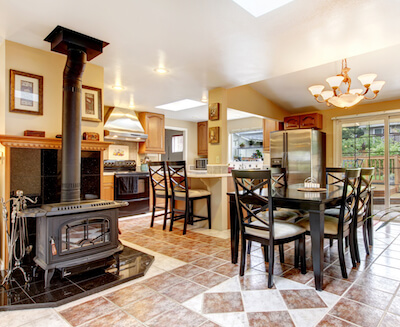Considering adding tile to your home? Before you select the color and the pattern, you’ll also need to decide how the tile will be installed. Tiles come in many shapes and sizes, and as such, can be installed in a variety of different patterns. Spend a little time online searching for what you love. Then bring that with you when you shop.
Grid Pattern
 The most common way of laying out tiles is in a simple grid pattern. Depending on the size of the tiles and your room, this is one of the most cost effective and easy ways to install without waste. Tiles are laid side by side, together, to create its own inherent pattern. It works perfectly no matter how big or small the tiles are.
The most common way of laying out tiles is in a simple grid pattern. Depending on the size of the tiles and your room, this is one of the most cost effective and easy ways to install without waste. Tiles are laid side by side, together, to create its own inherent pattern. It works perfectly no matter how big or small the tiles are.
Running Bond or Offset Pattern
This is the next easiest pattern to create. Think of it as if you were laying bricks. This pattern can be done with both square and rectangular tiles, alternating how they are laid into place. The first row is laid with the second row directly underneath, so that the corner of the tile sits at the center-point of the one above. It creates a running appearance. The advantages are it creates a little extra texture and softens the overall space.
Harlequin Pattern
The harlequin pattern involves placing square tiles at an angle, on the diagonal at 45 degrees to the walls. This gives an illusion of greater space, making a room appear bigger than it truly is. It’s particularly useful in spaces with unusual shapes, giving the pattern the opportunity to pull your view into focus. You’ll see it a lot with black and white alternating tiles, though any color combination can work.
Herringbone Pattern
You’ll often see this in use with parquet flooring. The Herringbone pattern combines interlocking rectangular tiles set at a 45 degree angle to the wall. Depending on the size and style, the pattern usually is laid lengthwise along the longest wall to maximize the effect.
Chevron Pattern
This is a close relative to the Herringbone pattern, with its main impact to create a classy look in any room. The Chevron pattern lays tiles out in rows of parallelograms, with each row facing in the opposite direction to the one next to it, creating a V shape. The sharp central line of the V creates a zigzag pattern that contrasts or blends perfectly, depending on the color and the style.
Basketweave Pattern
The Basketweave pattern is two brick-shaped tiles set horizontally against two brick-shaped tiles set vertically. It’s an easy pattern to create and adds texture and style without too much effort. This can create texture either with tiles all the same color, or consider interweaving tiles of different color or pattern for an interesting look.
So which pattern will you choose? Which is the right one for you?
